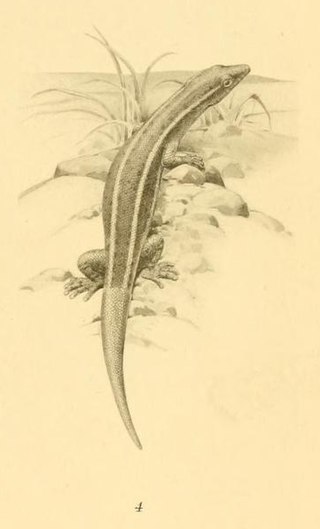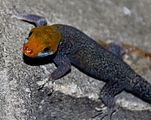
Pseudogonatodes is a genus of sphaerodactylid geckos, often known as South American clawed geckos, containing seven described species. Like most sphaerodactylines, Pseudogonatodes are miniaturized geckos and among the smallest living lizards. They are diurnal and terrestrial, foraging among leaf litter and rotting wood on the ground. Prey items are primarily small arthropods such as springtails, insect larvae, and orthopterans. Though locally common and not strongly threatened with extinction, most species occupy restricted ranges in remote tropical forests. The most widespread and well-studied species, Pseudogonatodes guianensis, is found throughout the Amazon rainforest.

Trinidad and Tobago are continental islands with a geologically very recent history of direct land bridge connection to South America. As a result, unlike most of the Caribbean Islands, Trinidad and Tobago supports a primarily South American flora and fauna and has greater diversity of plant and animal species than the Antilles. However, rates of endemism are lower than in the rest of the Caribbean because there has been less time for genetic isolation from mainland populations because of the history of land bridge connections and hence fewer opportunities for speciation, and so a greater proportion of the species in Trinidad and Tobago are also found on the South American mainland. Trinidad is nearer to mainland South America and has been directly connected to the mainland via land bridges more often and for longer periods than Tobago. This, as well as Trinidad's larger size and more varied topography and hydrology compared to that of Tobago allow greater species and ecosystem diversity on the former compared to that on the later of the islands.
The Paraguanan ground gecko is a species of lizard in the family Sphaerodactylidae.

Gonatodes albogularis, which has been called a number of vernacular names in English, is a smallish species of gecko found in warm parts of Central and South America, Cuba, Hispaniola and Jamaica. They prefer to live in tropical dry forest habitats. It is sexually dimorphic: the male is colourful, while the female is a more drab grey. The fingers do not have lamellar pads for climbing smooth surfaces like many other geckos but instead have normal claws like most lizards. At one time the species had a breeding population in southern Florida, especially Key West, but this population appears to have died out by the early 1990s. They are believed to be able to tell the difference between brightness and hues of conspecifics. Males are incredibly aggressive with territory defense against both other males and potential predators.
Dixon's leaf-toed gecko is a species of lizard in the family Phyllodactylidae. The species is endemic to Venezuela.
Gonatodes alexandermendesi is a species of lizard in the family Sphaerodactylidae. The species is indigenous to northern South America.

The brilliant South American gecko, also known commonly as the brilliant clawed gecko, is a species of lizard in the family Sphaerodactylidae. The species is native to northern South America.
The South American gecko is a species of lizard in the family Sphaerodactylidae. The species is endemic to Brazil.

Haseman's gecko is a species of lizard in the family Sphaerodactylidae. The species is indigenous to northern South America.
Gonatodes nascimentoi is a species of lizard in the family Sphaerodactylidae. The species is endemic to Brazil.
Peters' gecko is a species of lizard in the family Sphaerodactylidae. The species is endemic to Venezuela.

Gonatodes riveroi is a species of lizard in the family Sphaerodactylidae. The species is endemic to Colombia.
Roze's gecko, also known commonly as limpiacasa, is a species of lizard in the family Sphaerodactylidae. The species is endemic to Venezuela.
The Estados Sucre gecko is a species of lizard in the family Sphaerodactylidae. The species is endemic to Venezuela.
The Sarisariñama Forest gecko is a species of lizard in the Sphaerodactylidae family native to Venezuela.
The Estado Aragua gecko, also known commonly as the ring-necked clawed gecko, is a species of lizard in the family Sphaerodactylidae. The species is endemic to Venezuela.

The Tobago least gecko is a species of lizard in the family Sphaerodactylidae. The species is endemic to the Caribbean and northern South America.
Alopoglossus kugleri, also known commonly as Kugler's largescale lizard, is a species of lizard in the family Alopoglossidae. The species is endemic to Venezuela.













